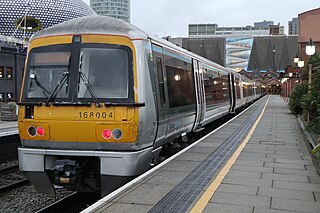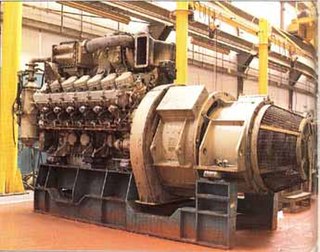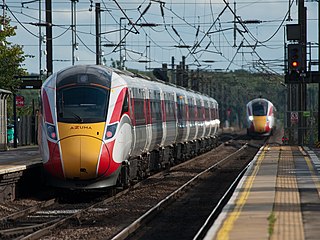Related Research Articles

The InterCity 125 (originally Inter-City 125) or High Speed Train (HST) is a diesel-powered high-speed passenger train built by British Rail Engineering Limited between 1975 and 1982. A total of 95 sets were produced, each comprising two Class 43 power cars, one at each end, and a rake of seven or eight Mark 3 coaches. The name is derived from its top operational speed of 125 mph (201 km/h). At times, the sets have been classified as British Rail Classes 253, 254 and 255.

Great Western Railway (GWR) is a British train operating company owned by FirstGroup that operates the Greater Western passenger railway franchise. It manages 197 stations and its trains call at over 270. GWR operates long-distance inter-city services along the Great Western Main Line to and from the West of England and South Wales, inter-city services from London to the West Country via the Reading–Taunton line, and the Night Riviera sleeper service between London and Penzance. It provides outer-suburban services in West London; commuter services from its London terminus at London Paddington to the Thames Valley region, including parts of Berkshire and Buckinghamshire, and Oxfordshire; and regional services throughout the West of England and South Wales to the South coast of England. Great Western Railway provides and maintains the Electrostar Class 387 fleet for Heathrow Express.
Brush Traction was a manufacturer and maintainer of railway locomotives in Loughborough, England whose operations have now been merged into the Wabtec company's Doncaster UK operations.

Class 252 was the classification allocated to the prototype High Speed Train (HST) unit, numbered 252001.

The British Rail Class 41 were two powercars built in 1972 by British Rail Engineering Limited's Crewe Works to operate with the prototype High Speed Train (HST) with Mark 3 carriages.

The British Rail Class 43 (HST) is the TOPS classification used for the InterCity 125 High Speed Train (formerly Classes 253 and 254) diesel-electric power cars, built by British Rail Engineering Limited from 1975 to 1982, and in service in the UK since 1976.

The Class 168Clubman is a British diesel multiple unit (DMU) passenger train used on Chiltern Line services between London Marylebone and the West Midlands. The trains were built by Adtranz at the Derby Litchurch Lane Works in several batches from 1998.

The British Rail Class 56 is a type of diesel locomotive designed for heavy freight work. It is a Type 5 locomotive, with a Ruston-Paxman power unit developing 3,250 bhp, and has a Co-Co wheel arrangement. Enthusiasts nicknamed them "Gridirons", due to the grid-like horn cover on the locomotive's cab ends fitted to nos. 56056 onwards. Under its Romanian railway factory nomenclature, the locomotive was named Electroputere LDE 3500, with LDE coming from Locomotivă Diesel-Electrică and the 3500 being the planned horsepower output.

The New Measurement Train (NMT), affectionately nicknamed the Flying Banana, is a specialised train which operates in the United Kingdom to assess the condition of track so that engineers can determine where to work. It is a specially converted InterCity 125, consisting of two Class 43 power cars and five or six Mark 3 carriages. It can check the condition of most main lines and some secondary routes operating on a four weekly cycle. This cycle replaced its original 13-week cycle after the introduction of the Plain Line Pattern Recognition (PLPR) Design Patrolling Program.
Paxman was a major British brand of diesel engines. Ownership has changed on a number of occasions since the company's formation in 1865, and the brand is now part of MAN Energy Solutions. At its peak, the Paxman works covered 23 acres (9.3 ha) and employed over 2,000 people. Early Paxman diesel engines carried the name Paxman Ricardo.

The British Rail Class 210 was a type of diesel-electric multiple unit (DEMU) passenger train designed and constructed by British Rail Engineering Limited's Derby Litchurch Lane Works.

CrossCountry is a train operating company in the United Kingdom owned by Arriva UK Trains, operating the current CrossCountry franchise.

Blackstone & Co. was a farm implement maker at Stamford, Lincolnshire, United Kingdom.

The Paxman Valenta, also known as Y3J and RP200, is a diesel fuelled internal combustion engine formerly made by Paxman in Colchester, England. It was originally developed for, and previously used in the British Rail (BR) Class 43 diesel-electric locomotives, a pair of which powered the InterCity 125 High Speed Train (HST) in a push-pull train set configuration. The Valenta has also been used for electricity generation in diesel generators on offshore oil rig platforms in British waters.

Diesel multiple units and railcars are trains, usually with passenger accommodation, that do not require a locomotive. Railcars can be single cars, while in multiple units cars are marshalled together with a driving position either end. As of December 2010, 23 percent of the rail passenger cars used on Network Rail are part of a diesel multiple unit.

The British Rail Class 801 Azuma is a type of electric multiple unit (EMU) built by Hitachi Rail for London North Eastern Railway. The units have been built since 2017 at Hitachi's Newton Aycliffe Manufacturing Facility and have been used on services on the East Coast Main Line since 16 September 2019. As part of its production, the Class 801 units were ordered as part of the Intercity Express Programme and are in the Hitachi AT300 product family, alongside the closely related Class 800 units. LNER have branded the units as the Azuma, just like on their Class 800 units.

Bocayna Express is a catamaran fast ferry operated by the Spanish-Norwegian shipping company Fred. Olsen Express between the Canary Islands of Fuerteventura and Lanzarote in the Atlantic Ocean. It was delivered to Fred. Olsen in September 2003 and has been operating the route between the towns of Corralejo (Fuerteventura) and Playa Blanca (Lanzarote) since then. The ship is named after the Bocayna strait which separates the two islands it serves.
The 125 Group is a railway heritage group in England dedicated to the preservation of the InterCity 125s.
References
- ↑ "The Design and Development of the 12VP185". Institution of Diesel & Gas Turbine Engineers Transactions.
- ↑ "New engine for 43170". The Railway Magazine (1121): 55. September 1994.
- ↑ "Paxman wins order for seven 12VP185 engines". Rail (255): 9. 21 June 1995.
- ↑ "Life-extended Angel HST rolls out of Brush for £1.5m trial". Rail (514). 25 May 2005.
- ↑ "GNER confirms German built MTU engines for HST fleet rebuild". Rail (544): 12. 19 July 2006.
- ↑ "Brush wins XC Class 43 HST overhaul deal". Rail (586): 64. 27 February 2008.
- ↑ "East Midlands Trains goes for VP185s". Today's Railways UK (71): 58. November 2007.
- ↑ "Existing EMT fleet". Rail (877): 10. 24 April 2019.
- ↑ "Double Paxman demise". Modern Railways (868): 50. January 2021.
- ↑ "Third 43 with Colas". Rail (924): 28. 10 February 2021.
- ↑ "LSL acquires more power cars". Rail (931): 27. 19 May 2021.
- ↑ "MTU looks at IC125 power". Rail Business Intelligence (118): 6. 20 January 2000.
- ↑ "Market". Railway Gazette International : 10. April 2000.
- ↑ "Colchester: MAN Diesel & Turbo UK creates new jobs after winning £39m contract in Taiwan". EADT.co.uk. East Anglian Daily Times. 2 May 2014. Retrieved 23 July 2023.
- ↑ "MAN Energy Solutions confirms closure of Colchester site". MAN-ES.com. MAN Energy Solutions. 5 November 2020. Retrieved 23 July 2023.